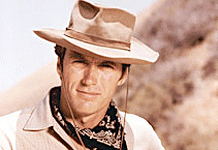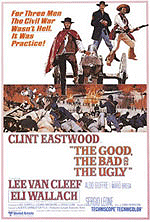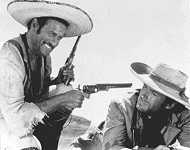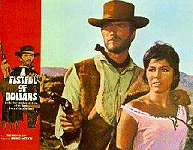Sixties
City presents
a wide-ranging series of
articles on all aspects of the Sixties, penned by the creator of the iconic
60s music paper Mersey
Beat
|
Sixties
City presents
a wide-ranging series of
articles on all aspects of the Sixties, penned by the creator of the iconic
60s music paper Mersey
Beat
|
||||||
|
 |
A hard-eyed, cheroot-smoking stranger wearing a poncho rides into a dusty
town on the Mexican border. A bunch of toughs warn him to get out of town
and scare off his mule with a hail of bullets. The man rides into town again,
challenges the four thugs and shoots them all. The Man With No Name arrived on the screen in ‘A Fistful of Dollars’, creating a mythic movie legend, turning Clint Eastwood into a star and inspiring a new genre, the spaghetti western. Tragically, the man who created the enigmatic cowboy, Sergio Leone, died during the 25th anniversary year of his famous film. |
 |
He
was born in 1926, the son of Italian director Roberto Roberti. Leone had
written a western based on the Akira Kurosawa film ‘Yojimbo’ in which a
lone samurai enters a township, manipulates them into fighting each other,
then kills off the survivors. Leone had raised a budget of $200,000 to make
the western and had approached a number of American actors in Europe to
take the leading role. One of them was Richard Harrison and he mentioned
Clint Eastwood, who’d been successful on American TV in the series ‘Rawhide’.
Leone approached Eastwood’s agents with an offer of $15,000 and a deal was struck. Under Leone’s direction, Eastwood became the archetypal, unshaven anonymous hero of a film which became a huge box-office success in Europe, although it wasn’t released in America until a few years later due to legal problems caused by the script’s resemblance to ‘Yojimbo’. Eastwood had suddenly become the No.1 box-office attraction in Italy, ‘the fastest draw in Italian movies’ and was hailed by Vittorio de Sica as ‘the new Gary Cooper’. The film was shot in Spain, featured an insidious musical score by Ennio Morricone, was extremely violent, but proved to be a shot-in-the-arm for the waning western genre. |
 |
 |
The
Man With No Name learns that the town of San Miguel is controlled by two
rival gangs, one headed by Ramon Rojo, the other by Sheriff John Baxter.
After shooting four of Baxter’s men, he’s signed on as a hired gun by the
Rojos and witnesses the gang's ambush of a group of Mexicans who had been
guarding a shipment of gold. He sets the two gangs against each other and
rescues a woman held hostage by the Rojos. The stranger is then captured
and beaten by the Rojos but escapes. The gang think the Baxters are holding
him and attack and wipe out the whole clan. Then the stranger returns, kills
the remaining Rojos and rides out of town. Leone approached Clint again
in the spring of 1965 to appear in a sequel, ‘For A Few Dollars More’. This
would have a budget of $600,000. Another American actor, Lee Van Cleef and
an Italian star Gian Maria Volonte had been signed to appear. Eastwood was
now aware of his drawing power in Europe and was able to demand and get
a salary of $50,000. Set in a period following the American Civil War, it concerns the efforts of two bounty hunters to track down a particularly nasty killer, Indio, who has a price of $100,000 on his head. The Man With No Name is interested in the money, the other bounty hunter, Colonel Mortimer, is hunting Indio because he was responsible for the death of Mortimer’s sister. The two team up, gain Indio’s confidence and are invited to join his gang on a bank raid. The raid is carried off so swiftly and efficiently that the two bounty hunters are unable to stop it. They manage to steal the money from the bandits, but are captured and tortured. Indio sets them free, and then sends his gang after them to kill them. The two men manage to shoot every one of Indio’s gang and The Man With No Name lets Colonel Mortimer avenge his sister’s death. The third 'Man With No Name' feature was an epic, with a budget of $1,200,000. Clint was to be paid $250,000 and a share of the profits. Lee Van Cleef also starred, but this time not as Colonel Mortimer, but as the evil Setenza. Another American actor, Eli Wallach, was signed to complete the trio in ‘The Good, the Bad and the Ugly’. During the American Civil War, three men are searching for a cashbox containing $200,000 in stolen money. A Mexican gunman called Tuco, the criminal Setenza and The Man With No Name. |
| Tuco
and the stranger team up and set off in search of a soldier who knows the
location of the strongbox. Tuco betrays his accomplice and decides to claim
the reward money of $4,000 for The Man With No Name by gathering some thugs
to attack him. The stranger kills the four men, but is captured by Taco
and taken into the desert. They encounter a wagon with dead and dying soldiers
and the stranger discovers the secret location of the box from one of the
soldiers before he dies. Taco and The Man With No Name become allies again
and after various adventures meet with Setenza and the three of them square
up for a gunfight at the graveyard site of the treasure. The ‘paella trilogy’
as the three films were called, soon made Eastwood a star in his own country
when the first two films were released in 1967 and the third a year later.
The on-screen adventures of The Man With No Name came to an end, but Eastwood
was to subsequently appear in several American westerns which owed much
to the influence of the Leone films, beginning with ‘Hang ‘Em High’. Dave Roberts of the Clint Eastwood Appreciation Society has an interesting theory about the trilogy. He says, “We know the films were made in the order they were released, but I would argue that, like the ‘Star Wars’ movies, the director Sergio Leone had planned the 'Dollar' films in a different order and ‘The Good, the Bad and the Ugly’ was, or should have been, the first in the trilogy". |
 |
 |
“And what of the famous poncho? After the battle to destroy the bridge,
Blondie (the name Taco calls The Man With No Name) helps a dying soldier
boy as he gives him a puff of his cigar. It is then, almost at the end of the film, that he picks up the poncho lying across a field cannon and is fully dressed as The Man With No Name we have come to know. “My theory that ‘The Good, the Bad and the Ugly’ should have been the first in the trilogy is also given credence by the dates in the films. ‘The Good, the Bad and the Ugly’ is set during the American Civil War which took place during 1861 through to 1865, yet in ‘A Fistful of Dollars’, which was made and released prior to ‘The Good, the Bad and the Ugly’, the stranger leans on a tombstone in which we clearly see the date of the deceased was 1873 – eight years later.” An interesting theory. Now that Leone has passed away, there is no chance of ever finding out what became of The Man With No Name. It would have been intriguing if Eastwood had made a fourth film in the series, years after the original, and continued with The Man With No Name character, just as he did with Harry Callaghan in the ‘Dirty Harry’ movies. (note, we have since seen 'Pale Rider'!) |
|
Article
|